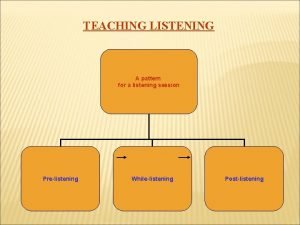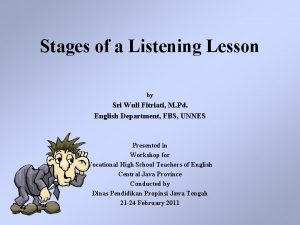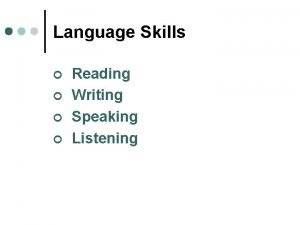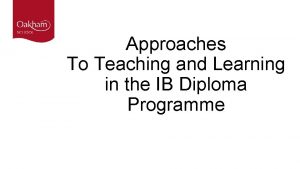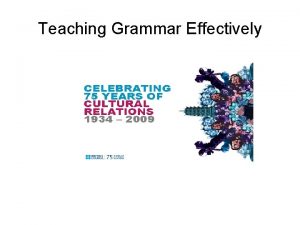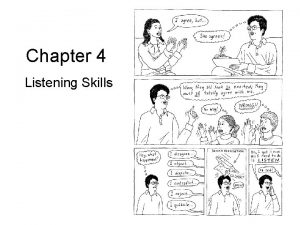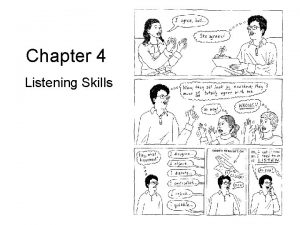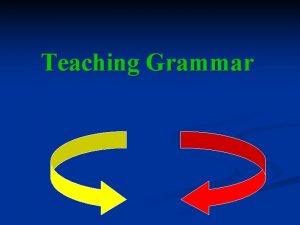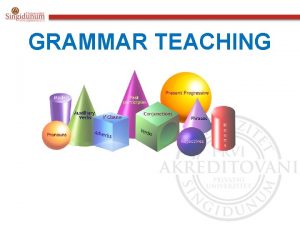Listening skills Listening in language teaching approaches Grammar









- Slides: 9

Listening skills

Listening in language teaching approaches � Grammar • Translation Method The main goal of learning the language is to be able to read its literature. Reading and writing are the main focus. Vocabulary is taught through translation. The method focuses on translating sentences into and out of the L 2. Accuracy is important , as all learning leads to an exam. Grammar is taught deductively (General rule to specific examples). The L 1 is the medium of instruction. • Learning goals lead to listening: None • • •

� • • The Direct Method Classroom instructions was conducted exclusively in the target language. Only everyday vocabulary and sentences were taught. Oral communication skills were built up in a carefully graded progression organized around question-andanswer exchanges between teachers and students in small, intensive classes. Grammar was taught inductively (Ss. detect, notice patterns and work out the rule. New teaching points were introduced orally. Both speech and listening comprehension were taught. Correct pronunciation and grammar were emphasized. Learning goals lead to listening: listen and answer the questions.

� Audio lingual approach � * Approach to listening emphasizes first listening to pronunciation and grammatical forms and then imitating those forms by way of drills and exercises. � Learning goals lead to listening: to pattern match; to listen, imitate, memorize. � Activity: - What is he reading? He’s reading a book. - What is she reading? She’s reading a book.

� The communicative approach � * looks at what people do with language and how they respond to what they hear. � Activities need to be, in some way, communicatively useful for students (real life aspects e. g. information gaps, choice of what to say, and feedback to what has been said? � Or activities that involve actions e. g. filling in a form, answering a telephone. � In the above activities Ss. not only use what they have been taught but also use whatever language they have to complete the activity. � Learning goals related to listening: to process spoken discourse for functional purposes: to listen and interact with the speaker and/or complete a task.

� Integrated approach � * Learning goals related to listening: to develop listening as part of interactive communication; to develop critical listening, critical thinking, and effective speaking. �* Which approach do you mostly support? Why? � For specific levels of learners-elementary, intermediate, advanced-which approach to teaching listening do you consider most? Why? � When would an integrated approach to teaching listening be most appropriate?

Models of listening process � The bottom-up model � -listeners build understanding by starting with smallest units of the message: individual sounds or phonemes, combine them to words, to make up phrases, clauses, and sentences. � The top-down model � -listeners identify words as long as they are presented in context, e. g. the cat sat on the /mæ/ � Listeners rely on the prior contextual knowledge as well.

� The interactive model � Language is processed simultaneously at different levels (top-down/bottom-up). � In this parallel processing, phonological, syntactic, semantic, and pragmatic information interact, although it is not clear exactly how. � At low level: need to spend more time on developing basic bottom-up skills of decoding. More advanced: who mastered basic phonology and syntax (the arrangement of words and phrases to create well-formed sentences in a language), emphasis on developing top-down skills.

� How does our knowledge of information processing help us to teach listening ? � In groups, discuss some of the ways in which as L 1 listeners we can have problems when listening. What implications does this have when teaching L 2 learners? � For a group of learners you are familiar with, how do they usually approach developing their listening: by way of bottom-up, topdown, or interactive processing? How do you know?
 Pre while post listening activities
Pre while post listening activities Stages of a listening lesson
Stages of a listening lesson Communication skills reading writing speaking listening
Communication skills reading writing speaking listening Approach to learning ib
Approach to learning ib Pedagogical approaches to teaching math
Pedagogical approaches to teaching math Example of teacher dominated approach
Example of teacher dominated approach Define left linear grammar
Define left linear grammar The characteristics of traditional grammar
The characteristics of traditional grammar Unrestricted grammar example
Unrestricted grammar example Right linear grammar to left linear grammar
Right linear grammar to left linear grammar
